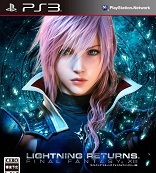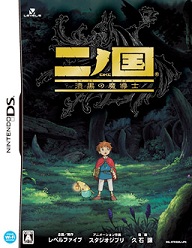Final Fantasy III
Nintendo DS
Reviewed: 02/01/2007
 Final Fantasy III, originally for the Famicom, was the first game in the series to introduce the Job System, and also the first Final Fantasy to have such commonplace additions as moogles and Fat Chocobo. Square Enix upped the anti with a complete remake of the game, which proves itself to be supurb in almost every manner.
Final Fantasy III, originally for the Famicom, was the first game in the series to introduce the Job System, and also the first Final Fantasy to have such commonplace additions as moogles and Fat Chocobo. Square Enix upped the anti with a complete remake of the game, which proves itself to be supurb in almost every manner.
The story begins abruptly when the Wind Crystal sinks beneath the earth and the orphaned hero Luneth decides to investigate. After a short dungeon, Luneth discovers that he is one of four destined Light Warriors, and is tasked with finding his other three comrades before returning to the crystal. He quickly assembles a team consisting of the bookish Arc, the confident Refia, and the determined soldier Ingus. After ridding the land of a curse placed by a Djinn, they present themselves to the crystal, who gives them the shards of heroes past and presents them with the task of vanquishing the darkness. The tale itself may seem cliché for the genre, but is presented remarkably well. It is easy to get drawn into this world and its plight. The dialogue is well written without being overbearing, and minor-named NPCs each have a believable personality which does not detract from the gameplay.
Gameplay is arguably the game’s strongest element. Each character has access to jobs unlocked by crystals they meet in their adventures, and each class has its own special strengths and weaknesses. Characters can change jobs at will, but the change from one job to another has a transition period in which stats are lessened while the character adapts to their new job. The four heroes of the light are generally proficient with any of the classes made available, but as the classes have different effects on stat growth at each level certain characters may be tooled to fit certain rolls.
The battle system takes a step back to the original turn-based fair. All four characters decide what they will do, and then those attacks as well as the attacks of enemies take place. It would have been nice if there was some way to tell which character would go first, but this randomness does not detract from the game at all.
 |
| Despite slaughtering monsters by the thousands, the protagonists of FF3 still manage to keep their clothes prestine. |
One nice feature is the ability to play the game fully with the DS buttons, or with the stylus, or with both. Using the stylus does present some issues; clicking on specific enemies can be troublesome and buying 99 of an item can be a chore. The amount of double tapping needed can also be problematic, but in no means is a deal breaker.
The graphics push the DS in an amazing fashion. The game features true 3D graphics that keep the feel of the original Final Fantasy games. Each individual character brings a specific look to the collective jobs, the world map grows into a truly believable world, and certain dungeons and areas have a very nice stylized look to them. Sure, the 3D graphics may be simplistic compared to console games, but they are successful both in creating an interesting style and bringing the world to feel fully realized. It is a shame, however, that the game does not make the fullest use of both screens. For most of the game, the top screen is used for the world map. For some reason, the world map must be shown while in dungeons or in towns, as opposed to maps of dungeons or towns. In battles, all the action takes place on the touch screen, with nothing on the top. The top screen could have easily been used to better effect, and it is bizarre that a game recreated for the DS would drop the ball like this.
The music is beautiful, and fits both the game as a remake and the game as a DS title. Most of the music is a throwback to the original game, remastered to fit the players of today. While at times repetitive, the music is never annoying and at times feels just as good as console counterparts. The speakers of the DS are pushed to their limits, but never seem to fail or sound tinny.
 |
| Every player of this game will have the same reaction when they discover they have to use the MogNet feature to unlock any extras. |
The game does have a significant number of hidden quests which can be unlocked via MogNet. Mognet allows players to send mail in game to either specific NPCs or other players. While the requirement to send letters to fellow players to unlock quests may not be a hindrance, the actual system used to do so is abysmal. Simply sending a letter requires that you and your friend both register friend codes before playing. Then, a letter is written by selecting each individual letter (using either the control buttons or the stylus) switching to a different page to enter a space. For example, sending the phrase “Hi 2 u!” is as complicated as selecting the capital H, selecting the letter “i,” selecting the second page, selecting the space button, selecting the page with numbers, selecting the number two, selecting the page with the space button AGAIN, selecting the space button, selecting the page of letters, selecting the lower case “u,” selecting the page with the space button and punctuation marks, and finally selecting the exclamation mark. Trying to send any real message becomes tedious. God forbid that a connection error occur when sending a message or else it will need to be re-entered in its entirety. This could have easily been prevented if a simple button allowed for the use of the space key, or if there were a space key on each page.
There is a lot to like about this game, even if one has beaten the original. The dungeons, while now in full 3D, are very faithful to the originals. The plot, while updated to reflect the change of four specifically named characters, still holds the same sense of grandness it did so long ago. It is a fresh take on a classic title, and the fact that Square Enix decided to make it for the DS as opposed to just rehashing the game like other NES counterparts makes the deal that much sweeter. Despite a few minor yet notable flaws, this game is a must have for every fan of the role playing genre that owns a DS.
-Tim Olsen
| Score Breakdown | ||
| Overall Very Good Out of 10 See our Review Criteria |
Gameplay | Great |
| Story | Very Good | |
| Graphics | Excellent | |
| Sound/Music | Excellent | |
| Replay Value | Excellent | |
| The Verdict: 7 | ||








